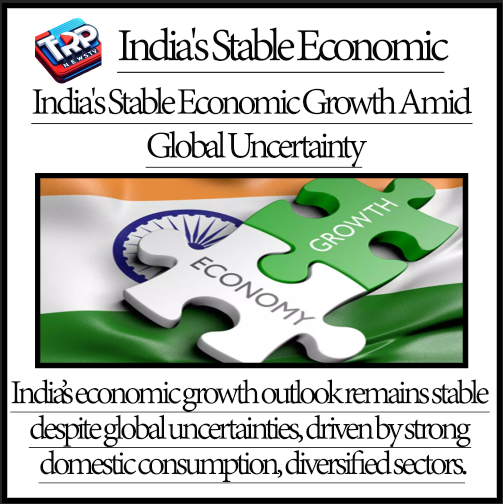
India’s Stable Economic Growth Amid Global Uncertainty
India’s economic growth has long been a topic of global interest. Despite facing significant external challenges, ranging from geopolitical tensions to the complexities of the COVID-19 pandemic and fluctuating commodity prices, India has demonstrated remarkable resilience. According to a recent report, India’s economic growth outlook remains stable, even in the face of global uncertainties. This continued stability is largely attributed to India’s strong domestic consumption, ongoing economic reforms, and a diversified economic base.
India’s Economic Stability Amid Global Challenges
India’s economy, one of the fastest-growing major economies in the world, has shown its ability to weather global storms. Although there are challenges such as inflationary pressures, global supply chain disruptions, and the effects of climate change, India’s economic fundamentals remain strong. The country’s large and diverse economy, a young workforce, and a rapidly growing middle class continue to provide significant momentum to growth.
Global uncertainties have affected almost every economy in some form or another. The pandemic severely disrupted supply chains, caused a rise in commodity prices, and led to inflationary pressures worldwide. On top of that, the ongoing Russia-Ukraine war and shifts in global trade dynamics have further complicated the global economic outlook. Yet, despite these turbulent times, India’s economy continues to expand, with key sectors such as agriculture, information technology, and pharmaceuticals leading the charge.
Key Factors Driving India’s Stable Economic Outlook
-
Strong Domestic Consumption India’s economy is heavily driven by domestic consumption, which accounts for about 60% of the country’s GDP. Despite global disruptions, India’s consumption patterns have remained resilient. Rising incomes, urbanization, and a growing middle class continue to fuel domestic demand. The Indian government’s emphasis on making the country a “hub of consumption” plays a significant role in this stability.
The post-pandemic economic recovery has also contributed to the revival of consumer spending, particularly in urban and semi-urban areas. Moreover, India’s e-commerce sector is expanding rapidly, with millions of people now shopping online for everything from electronics to groceries.
-
Agriculture and Rural Growth India’s agricultural sector, while facing challenges such as water scarcity and climate change, remains a key pillar of the economy. Agriculture continues to employ a significant portion of India’s population, particularly in rural areas. Government initiatives like the Pradhan Mantri Kisan Samman Nidhi (PM-KISAN) have provided financial support to farmers, while the government’s focus on rural infrastructure has bolstered rural growth.
Additionally, the sector has benefitted from a relatively stable monsoon season, which has helped maintain production levels of key crops. This has in turn ensured that rural demand remains strong, contributing to overall economic stability.
-
Diversified Economic Base India’s economy is not solely dependent on one or two sectors. The country has successfully diversified its economic base, with growth witnessed in services, manufacturing, and technology. India is one of the world’s leading IT outsourcing hubs, with a robust tech ecosystem. The services sector, particularly IT, business process outsourcing (BPO), and financial services, continues to thrive despite global challenges.
Additionally, the government’s “Make in India” initiative has promoted manufacturing, encouraging both domestic and foreign investment. India is emerging as a global manufacturing hub, with significant progress in sectors like automobile manufacturing, electronics, and renewable energy. The growing focus on sustainability and green energy solutions also positions India as a key player in the global economy.
-
Economic Reforms and Policy Support The Indian government has implemented several key economic reforms aimed at improving the ease of doing business, promoting foreign investment, and enhancing economic competitiveness. The Goods and Services Tax (GST) has simplified the tax structure, while the introduction of the Insolvency and Bankruptcy Code (IBC) has helped improve the business environment.
Furthermore, India has focused on building infrastructure through initiatives like the National Infrastructure Pipeline (NIP) and the Atmanirbhar Bharat Abhiyan (Self-Reliant India Campaign). These efforts have helped support economic growth and resilience, particularly during times of global uncertainty.
-
Inflation Control and Monetary Policy India’s central bank, the Reserve Bank of India (RBI), has played a crucial role in managing inflationary pressures and ensuring economic stability. Despite challenges such as global inflationary trends, the RBI has taken proactive measures to keep inflation within manageable limits. By adjusting interest rates and managing liquidity, the RBI has kept inflation in check, contributing to an environment conducive to growth.
The government’s fiscal policy has also helped to balance growth and inflation management, ensuring that economic stability remains intact despite external challenges.
Potential Risks and Challenges
While India’s economic growth outlook remains stable, there are certain risks that could impact the trajectory of its growth. Some of the key challenges include:
-
Global Supply Chain Disruptions: While India has shown resilience, disruptions in global supply chains continue to pose challenges, particularly for industries dependent on imports for raw materials and intermediate goods. The ongoing geopolitical tensions and trade disruptions could have a long-term impact on global trade, which may affect India’s export-driven sectors.
-
Inflationary Pressures: Although inflation is under control, it remains a concern due to rising commodity prices, particularly oil. As a major importer of crude oil, any spike in global oil prices could lead to increased inflation in India, which might impact consumer spending and reduce growth.
-
Climate Change: India is particularly vulnerable to climate change due to its dependence on agriculture and the fact that much of its infrastructure is located in coastal areas. Droughts, floods, and other natural disasters could have a significant impact on food production and economic growth.
-
Geopolitical Tensions: India is also impacted by geopolitical tensions in its neighborhood, particularly with neighboring countries like China and Pakistan. Any escalation of conflict could disrupt trade routes and impact investor confidence.
Conclusion
Despite these challenges, India’s economic outlook remains stable due to its strong domestic consumption, diversified economic base, strategic reforms, and supportive government policies. The country’s ability to adapt to global changes, coupled with its large, young workforce and technological prowess, makes it well-positioned to continue its upward trajectory in the coming years.
In summary, India’s economic resilience in the face of global uncertainties underscores its growing importance on the world stage. With continued reforms, strategic investments, and a focus on sustainability, India’s economic future remains bright, offering significant opportunities for growth, development, and global integration.





